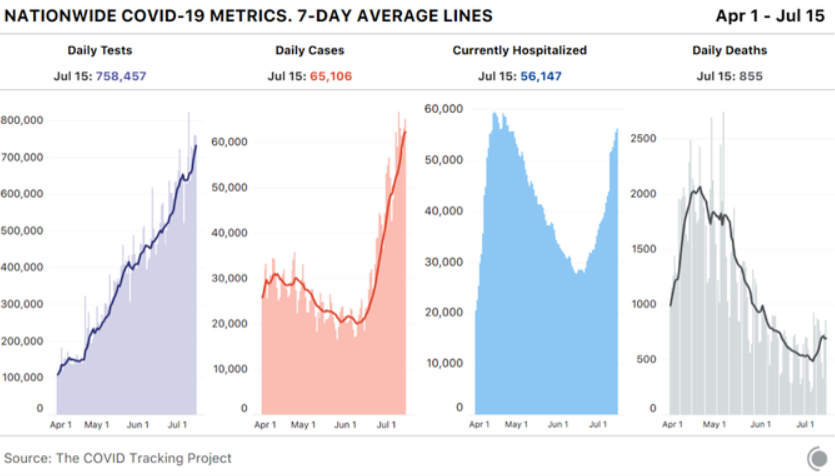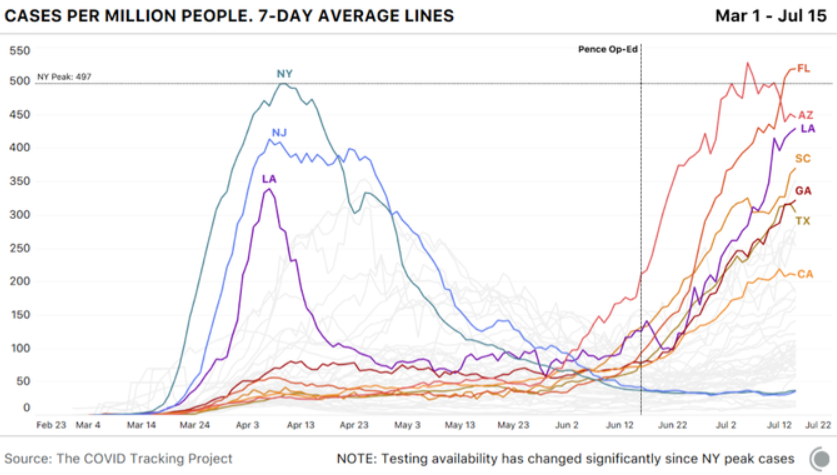Welcome to DU!
The truly grassroots left-of-center political community where regular people, not algorithms, drive the discussions and set the standards.
Join the community:
Create a free account
Support DU (and get rid of ads!):
Become a Star Member
Latest Breaking News
General Discussion
The DU Lounge
All Forums
Issue Forums
Culture Forums
Alliance Forums
Region Forums
Support Forums
Help & Search
General Discussion
Related: Editorials & Other Articles, Issue Forums, Alliance Forums, Region ForumsA Second Coronavirus Death Surge Is Coming
There was always a logical explanation for why cases rose through the end of June while deaths did not.https://www.theatlantic.com/health/archive/2020/07/second-coronavirus-death-surge/614122/

There is no mystery in the number of Americans dying from COVID-19. Despite political leaders trivializing the pandemic, deaths are rising again: The seven-day average for deaths per day has now jumped by more than 200 since July 6, according to data compiled by the COVID Tracking Project at The Atlantic. By our count, states reported 855 deaths today, in line with the recent elevated numbers in mid-July. The deaths are not happening in unpredictable places. Rather, people are dying at higher rates where there are lots of COVID-19 cases and hospitalizations: in Florida, Arizona, Texas, and California, as well as a host of smaller southern states that all rushed to open up. The deaths are also not happening in an unpredictable amount of time after the new outbreaks emerged. Simply look at the curves yourself. Cases began to rise on June 16; a week later, hospitalizations began to rise. Two weeks after that—21 days after cases rose—states began to report more deaths. That’s the exact number of days that the Centers for Disease Control and Prevention has estimated from the onset of symptoms to the reporting of a death.

Many people who don’t want COVID-19 to be the terrible crisis that it is have clung to the idea that more cases won’t mean more deaths. Some Americans have been perplexed by a downward trend of national deaths, even as cases exploded in the Sun Belt region. But given the policy choices that state and federal officials have made, the virus has done exactly what public-health experts expected. When states reopened in late April and May with plenty of infected people within their borders, cases began to grow. COVID-19 is highly transmissible, makes a large subset of people who catch it seriously ill, and kills many more people than the flu or any other infectious disease circulating in the country. The likelihood that more cases of COVID-19 would mean that more people would die from the disease has always been very high. Even at the low point for deaths in the U.S., roughly 500 people died each day, on average. Now, with the national death numbers rising once again, there’s simply no argument that America can sustain coronavirus outbreaks while somehow escaping fatalities. America’s deadly summer coronavirus surge is undeniable. And it was predictable this whole time by looking honestly at the data. In the United States, the rising severity of the current moment was obscured for several weeks by the downward drift of cases, hospitalizations, and deaths resulting from the spring outbreak in northeastern states. Even though deaths have been rising in the hardest-hit states of the Sun Belt surge, falling deaths in the Northeast disguised the trend.

It is true that the proportion of infections in younger people increased in June and July compared with March and April. And young people have a much lower risk of dying than people in their 60s and older. But, at least in Florida, where the best age data are available, early evidence suggests that the virus is already spreading to older people. Additionally, analysis of CDC data by The New York Times has found that younger Black and Latino people have a much higher risk of dying from COVID-19 than white people the same age. According to the racial data compiled by the COVID Tracking Project in concert with the Boston University Center for Antiracist Research, Latinos in Arizona, California, Florida, and Texas are 1.3 to 1.6 times more likely to be infected than their proportion of the population would suggest. It is telling that despite outbreaks all over Texas in recent weeks, the border region has been leading the state in deaths per capita. Even with cases surging, if hospitalizations were not rising, that might suggest that this outbreak might be less deadly than the spring’s. But hospitalization data maintained by the COVID Tracking Project suggested otherwise as early as June 23. On that date, hospitalizations began to tick up across the South and West, and they have not stopped. It’s possible we’ll match the national peak number of hospitalizations from the spring outbreak over the next week.

Even if better knowledge of the disease and new treatments have improved outcomes by 25 or even 50 percent, so many people are now in the hospital that some of them will almost certainly die. There was always a logical, simple explanation for why cases and hospitalizations rose through the end of June while deaths did not: It takes a while for people to die of COVID-19 and for those deaths to be reported to authorities. So why has there been so much confusion about the COVID-19 death toll? The second surge is inconvenient for the Trump administration and the Republican governors who followed its lead, as well as for Mike Pence, the head of the coronavirus task force, who declared victory in a spectacularly incorrect Wall Street Journal op-ed titled, “There Isn’t a Coronavirus ‘Second Wave.’” “Cases have stabilized over the past two weeks, with the daily average case rate across the U.S. dropping to 20,000—down from 30,000 in April and 25,000 in May,” Pence wrote. In the month since Pence made this assertion, the seven-day average of cases has tripled. Several individual states have reported more than 10,000 cases in a day, and Florida alone reported 15,000 cases, more than any state had before, on an absolute or per capita basis.

snip
much more at the top link
InfoView thread info, including edit history
TrashPut this thread in your Trash Can (My DU » Trash Can)
BookmarkAdd this thread to your Bookmarks (My DU » Bookmarks)
2 replies, 1073 views
ShareGet links to this post and/or share on social media
AlertAlert this post for a rule violation
PowersThere are no powers you can use on this post
EditCannot edit other people's posts
ReplyReply to this post
EditCannot edit other people's posts
Rec (14)
ReplyReply to this post
2 replies
 = new reply since forum marked as read
Highlight:
NoneDon't highlight anything
5 newestHighlight 5 most recent replies
= new reply since forum marked as read
Highlight:
NoneDon't highlight anything
5 newestHighlight 5 most recent replies
A Second Coronavirus Death Surge Is Coming (Original Post)
Celerity
Jul 2020
OP
Laelth
(32,017 posts)1. Highly informative essay. Recommended. k&r n/t
-Laelth
Initech
(100,108 posts)2. My brother said he only saw two COVID patients the entire last 3 days.
And this is in downtown Los Angeles. Something tells me though that this is the calm before the storm. ![]()